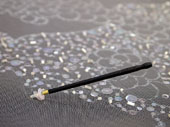
|
| Above,
threads of silk and cotton seem to pour
and swirl in intricate, hand-stitched
embroidery designs of beads, disks,
sequins, glass, crystals, lace and their
own patterned and built-up stitching:
It's all "precious goods"—maal. |
 edrolls and suitcases line the workshop's walls, but their owners are
not likely to get much sleep, nor will they be visiting their families
back in West Bengal and Bihar anytime soon. Nor is the
overhead television turned on, as it might be if a cricket match
were being played and work were slow. Only the day's several
tea breaks interrupt the breakneck schedule.
edrolls and suitcases line the workshop's walls, but their owners are
not likely to get much sleep, nor will they be visiting their families
back in West Bengal and Bihar anytime soon. Nor is the
overhead television turned on, as it might be if a cricket match
were being played and work were slow. Only the day's several
tea breaks interrupt the breakneck schedule.
In coming weeks, brides, grooms and their extended families
from many of India's top socialite families will depend
on these men to finish bedecking their wedding garments in
a manner that, in a former time, would have well pleased even
the most demanding prince or rajah. For design partners and
workshop owners Abu Jani and Sandeep Kholsa, this is as
it should be: Indian pride in the famous Indian art of embroidery, which they
have done much to foster.
Abu and Sandeep have placed Indian
embroidered garments, such as the shervani (knee-length coat fitted closely at the
waist), the gote (wide, flared pajama pants),
the ghagra (multi-panel wedding skirt), the
dupatta (stole-like head covering) and the
kurta and kurti (long and short tunic), on
Hollywood red carpets and Mayfair runways—
not to mention in Bollywood itself and
at the lavish parties of New Delhi industrialists.
Their Mumbai shop, in smart Kemps
Corner, sells saris for $9000 and shervanis
for $16,000. For a single wedding, some 50
garments might be sold to one family for the
several daytime and nighttime appearances
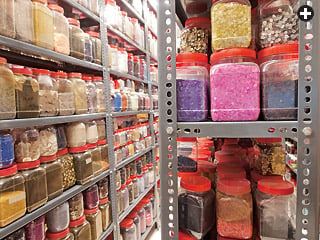 |
|
The art of Mughal-style embroidery starts
with an abundance of raw materials, from
a profusion of ornamental maal above to
thread, below, that varies by material, weight
and color. |
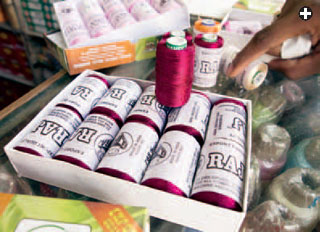 |
Yet for 37-year-old embroiderer Rehmat
Shaikh, a married man with a young son
in his West Bengal village four hours from
Calcutta, his monthly salary of 8000 rupees
($200) seems like decent pay. His brother
working on the railroad back home makes
much less, he says, and risks his life every
day. Shaikh meanwhile takes pride in his
precise and artful work. "I know no less
than 1000 different designs," he says, not an
unreasonable number given the great variety
of embroidery pieces—in metal, cotton,
silk, plastic, glass and Swarovski crystal, all
known collectively as maal, literally meaning
"material" or "stuff," but here with
the connotation of "precious goods"—that
he applies to the fabric with different stitches
and knots.
François Bernier, the French physician in Mughal emperor
Aurangzeb's court, wrote of much the same work 300 years
ago in his Travels in the Moghal Empire:
"Large halls are seen in many places, called
karkanahs, or workshops for the artisans. In
one hall, embroiderers are busily employed,
superintended by a master." He continued,
"[M]anufactures of silk, fine brocade, and
other fine muslins, of which are made turbans,
girdles of gold flowers, and drawers
worn by females, so delicately fine as to wear
out in one night" might cost up to 10 or 12
crowns, "or even more when embroidered
with fine needlework."
But in at least one way, things have
changed. Bernier noted, "In this quiet and
regular manner, their time glides away, no
one aspiring to any improvement in the condition
of life wherein he happens to have
been born. The embroiderer brings up
his son as an embroiderer." No more: Shaikh's
father was a farmer, and Shaikh wants
his own son to grow up to work as an
it
man in an office in Bangalore. Perhaps due
to the globalized garment trade and to the
growth of India's middle class, both at home
and abroad, whose members can afford
fine embroidery work, many more workers
have entered the embroidery trade than
in previous generations, and it seems likely
that many kinds of office work will be available
to the generation that will follow.
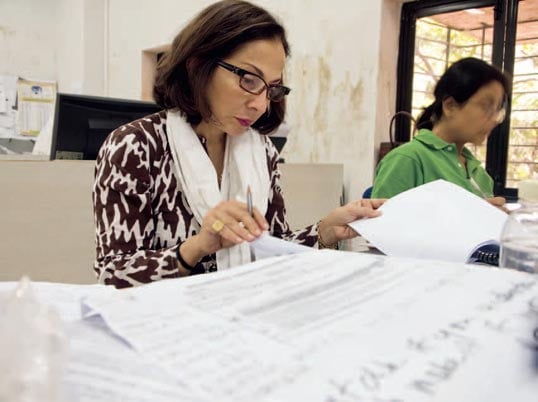 |
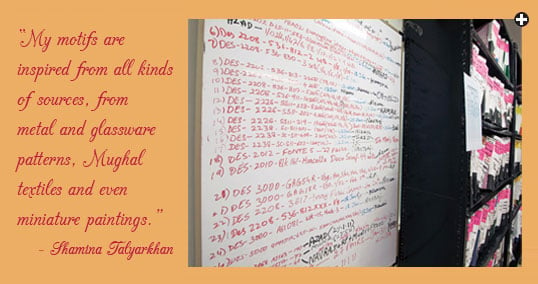 |
| Shamina Talyarkhan,
founder of Shameeza Embroideries, reviews
orders from New York, which are then listed
on an erasable board. |
Shaikh's specialty is zardozi. This uses
a straight needle with cotton or silk thread
in a cross-stitch, often to apply all varieties
of maal, frequently in gold and silver, to the
fabric. Zardozi is a highly creative art and
may use nothing more than colored threads
to create organic or geometric designs,
sometimes couched over a paper cutout
called a wasli to raise the pattern or runstitched
along the folds of a pleated metallic
ribbon, called gota, to create the veins and
ribs of a leaf or petal. The craftsman can
also freely modulate both the length of the
stitch and its orientation on the fabric, crosshatch
the stitching alternately on the diagonal
or use French knotting to vary shimmer
and smoothness.
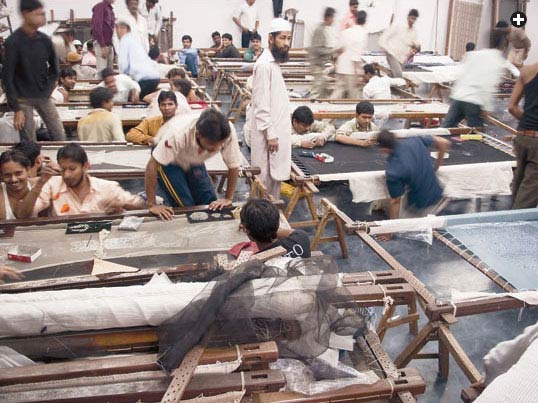 |
|
Working four, five or six to a frame, young craftsmen often choose the embroidery
trade in pursuit of upward mobility. |
Abu's and Sandeep's 33-year-old floor
supervisor is soft-spoken Firoz Malik, who
can lend a hand with the workshop's other
main embroidery technique, ari, which is done with the same
kind of hooked needle used in French tambour lace-making,
itself a craft of Eastern origin. Firoz's eighth-grade education is
considered advanced for a man in the needle trade.
The ari needle is held vertically like a dental pick, moving
up and down rapidly in a sewing-machine motion. Firoz
first picks up the maal one by one onto the barrel of his needle.
He punches the needle down through the fabric and, with his left
hand holding a spool of thread underneath
the embroidery frame, makes a quick loop
around the needle's hook before pulling the
thread back up through the fabric and over
a millimeter left or right, thereby fixing the
maal in place before making the next upand-
down needle punch. The ari needles are
of different sizes, depending on whether the
thread is single, double or triple, and according to
the diameter of the holes in the sequins and beads
that are being attached.
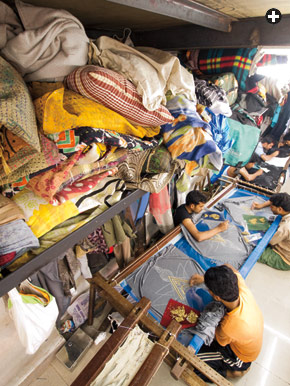 |
|
During the height of the wedding season,
many sleep in the shop at night and each
morning place their bedrolls on overhead
shelves. |
Ari work goes faster than zardozi, but if it's
done carelessly, the chain stitch on the underside
of the fabric can unravel if the thread is broken in
any one place. Having to tie stop knots to mend it
breaks the rhythm and jars the smooth, fast lines
that ari is known for, so embroiderers must get
it right the first time. A flower pattern measuring
10 by 25 centimeters (4 x 10") might take an ari man
15 hours, which is about half the time of a zardozi
job of the same area.
Both ari and zardozi embroidery work are said
to be of Persian origin and were perfected under the
Mughals. An even finer Persian embroidery called
chikan kari reached nearperfection
under the nawabs of Awadh in
the 19th century; that has been revived and
brought to an even higher level by Abu and
Sandeep. Using untwisted cotton thread on
cotton fabric in white and off-white tones,
chikan work is known for its 35 unique
stitches, including shadow (applied underneath
the fabric, so the top side is smooth
yet shaded from below); jaali (separates the
warp and weft threads into bundles of four
within a reinforced perimeter, thereby making
screen-like perforations in the fabric);
and murri (shaped like grains of puffed rice).
Each one is simple yet very elegant. The
chikan workers are all village women, and
they do not work with the men in Mumbai:
They work in a haveli, or country house,
outside Lucknow.
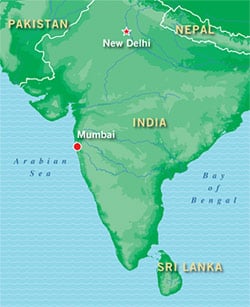 |
Abu and Sandeep's design department is
staffed with recent graduates of India's top
fashion institutes, all with a practical, problem-
solving outlook. One recent project was
to lighten a Rabari-style coat—traditionally
made by that tribe in the Kutch area of Gujarat—
which uses glass mirrors stitched into
place in a mosaic pattern. But such work is
impractical for modern wear and impossible
to drape attractively. The designers replaced
the glass with metal foil in different hues,
thus achieving the same reflective quality,
broadening the color palette and at the same
time lightening the wearer's shoulder load
enormously.
In the 16th century, in the time of the
Mughal emperor Akbar, his vizier Abu al-
Fazl ibn Mubarak wrote in the Ain-i Akbari,
a logbook of his emperor's reign:
His majesty pays much attention to
various stuffs; hence Irani, European,
and Mongolian articles of wear are
in much abundance…. The imperial
workshops in the towns of Lahore,
Agra, Fatehpur, Ahmedabad and
Gujarat turn out many masterpieces
of workmanship, and the figures and
patterns, knots and variety of fashions
which now prevail astonish experienced
travelers.… [A] taste for fine
material has since become general,
and the drapery used at feasts surpasses
every description.
 |
In central Mumbai, Shamina
Talyarkhan has long astonished even the
most experienced travelers with her eye for
fashion. Recently named by Time magazine
as one of the world's top businesswomen in
the luxury trade, she remembers how she
started in the 1970's. Freshly arrived in
New York, wearing saris and lugging suitcases
of embroidered dresses up and down
Fifth Avenue, she found disappointment.
"They didn't buy," she says, "but I learned
something important—how to design and
sell embroidered pieces to famous couturiers—
people like Valentino, Yves Saint
Laurent, Escada, Ralph Lauren and Reem
Acra—so they could fit them into their
own creations."
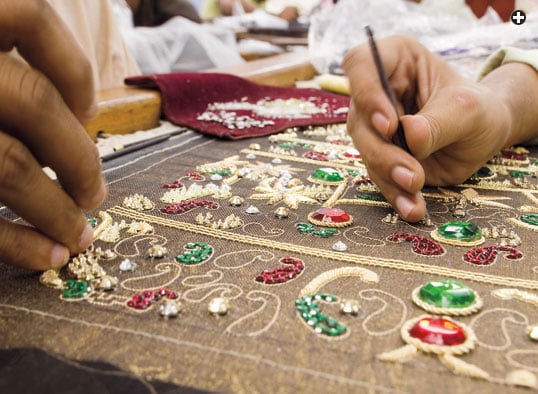 |
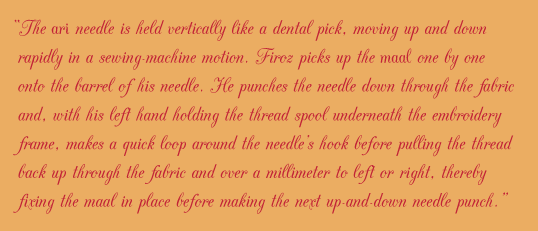 |
Now, her busy workshop in Mumbai's
Worli district turns out swatches, samples
and full production runs for these and other
top designers. "We start with pure ideas,"
she says, "playing back and forth with mood
prompts and word associations. Then I turn
them into a swatch, and I get feedback, then
into a full size sample, and get more feedback.
Only then do I go into production."
The order board hanging near the supervisors'
station lists current and upcoming
jobs by level of urgency. Today, all of them
seem to need to be finished and shipped
by tonight.
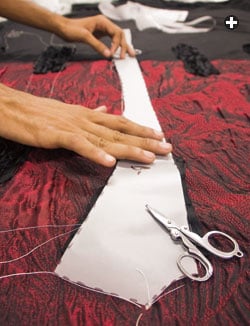 |
Her men embroider Mughal-style elements
onto panels of western fabrics like
tulle, georgette and chiffon, which are then
re-sewn into garments ranging from ball
gowns and wedding dresses to fancy sweaters
and casual jackets. At first, it seems
strange to see fine Indian stitchery combined
with suede, or crushed and coiled crepe, or
tiger-stripe-printed silk, pleated and covered
with peekaboo black netting. But then
it all makes perfect fashion sense: Just as in
Akbar's time, it is an amalgam of diverse
tastes and traditions.
"My motifs are inspired by all kinds of
sources," says Shamina, as she points to
her library of pattern books and museum
catalogues, "from bidri, or inlaid metal, and
glassware patterns, Mughal textiles in the
V&A's collection, even miniature paintings.
But I had to educate my workers too about
quality control. My fabrics are mostly pale
greens and pinks, lavenders and peach tones,
and their hands were often soiled from long
bus commutes. Luckily, soap flakes usually
did the job. My biggest problem was
the apprentices' reluctance to use thimbles.
Blood dripping from pricked fingers just
doesn't wash out!"
The process of arranging an embroidery
frame is almost as complicated as setting
up a loom. Cloth must be stretched
tight to be embroidered, but Shamina's fabrics
are usually too delicate to be stretched
and embroidered directly; they must first
be stitched flat onto a stronger nylon-mesh
backing. The backing is then stretched over
the frame by a cord with multiple loops.
The desired patterns are then pounced
onto the stretched fabric using chalk powder
and paper templates perforated with pinholes.
Four to six men can work comfortably
around one frame, sometimes working
on a single large pattern, more frequently working
on multiple smaller pieces to be cut out
and sewn individually onto sleeves, backs and bodices.
The needle must be pushed firmly through both the
base fabric and the nylon-mesh backing.
When the job is complete, the mesh threads are
unraveled and pulled away one by one, leaving the
fine fabric free with the embroidery work intact.
 |
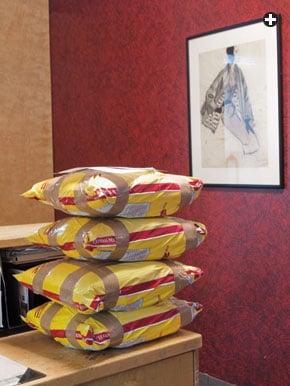 |
|
Haze silhouettes skyscrapers in Mumbai, top; in New York,
above, a shipment of embroidery awaits unpacking at Shameeza Embroideries,
where other finished dresses, below, await their clients. |
Twenty-six-year-old Muhammad Khalid
from Bihar is working on a painstaking
four-handed job with his bench-mate
Tasleem Muhammad, shaping and holding
down the pleats of a flower design to
be sewn tightly in place. If it is not done
right and consistently, the quality controllers
who inspect each piece will send it back
to be redone. Muhammad and Tasleem are
part of a larger production team responsible
for a six-week job: 270 pieces of four panels
each, later to be cut out of the fabric and
tailored individually into each dress.
At another frame, ari workers are fixing
five different kinds of blue beads as
well as square and round sequins onto the
fabric. A needleman picks up each shape
in a repeated sequence, sometimes stacking
two of the same shape at a single position
in order to add a third dimension to the
design. To save time and motion, an expert
might pick up multiple beads onto his needle,
which he can drop one by one into each
chain stitch without having to pick them
up individually. A needleman's eyes are the
first thing to deteriorate in this work—not
backs or legs as in Mumbai's unskilled
trades—and threading a needle is easy in
comparison to stitching tiny beads into a
perfect line with zero tolerance for disorder.
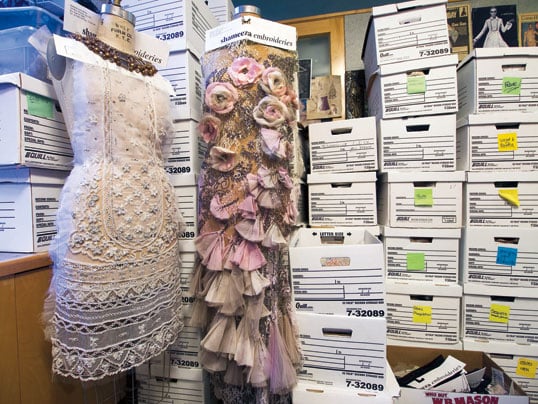 |
Shamina's best workers, she says, are her
swatch makers, because it is the swatches
that are scrutinized back in the New York or
Paris design studios before approval for full
production. Even so, swatches sometimes
go through several versions, sent back and
forth to Mumbai with cryptic comments
handwritten on the order card, like something
on a doctor's prescription pad: "Only
1 and 3 dot rows, no 4 dots," or "Add space
between floating fade out beads," or "Fewer
sequins per dot," and on and on.
When jobs back up in Shamina's workshop,
she sends them out to her subcontractor,
Muhammad Muazzam Siddiqui, one of
Mumbai's many start-up embroidery entrepreneurs
who are satisfying the demand
for handmade pieces, which has exploded
thanks to Internet-based marketing and
sales. Any Web site selling low-end Indian
garments offers much the same kind of ari
and zardozi stitchery, but the difference is
not only that the maal is plastic and glass
rather than gold and crystal, but also—and
critically—that the detail, the quality control
and the overall coverage of the cloth
is far less than what Shamina, Abu and
Sandeep produce.
Among Siddiqui's 40 employees, all
clustered around 15 embroidery frames,
is 22-year-old Mustaqim Shaikh, from
Mednapur village in West Bengal. Shaikh
started as an apprentice near his home
after finishing fourth grade and, ever since
coming to Mumbai six years ago, has felt
that he made the right decision. Looking
over at his boss, he says he sees himself
wearing those shoes in the not-so-distant
future. After all, he explains, in a prospering
country that adds hundreds of thousands
of cars to its roads every month, it is
only natural that more people than ever are
buying the most finely embroidered kurtas
and kurtis, saris and dupattas.


|
Louis Werner ([email protected])
is a writer and filmmaker living in New York City.
|

|
David H. Wells (www.davidhwells.com)
is a freelance documentary photographer
affiliated with Aurora Photos.
He specializes in intercultural
communications and the use of light and
shadow to enhance visual narrative, and has
twice won Fulbright fellowships for work in
India. His photography regularly appears in
leading magazines. A frequent teacher of
photography, he publishes The Wells Point
at www.thewellspoint.com. |





